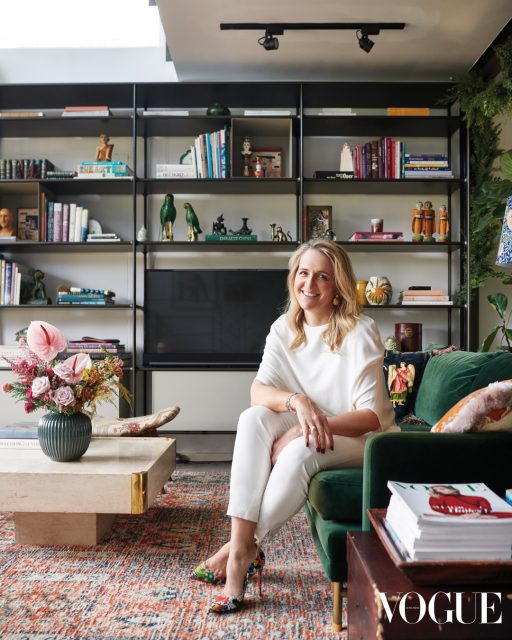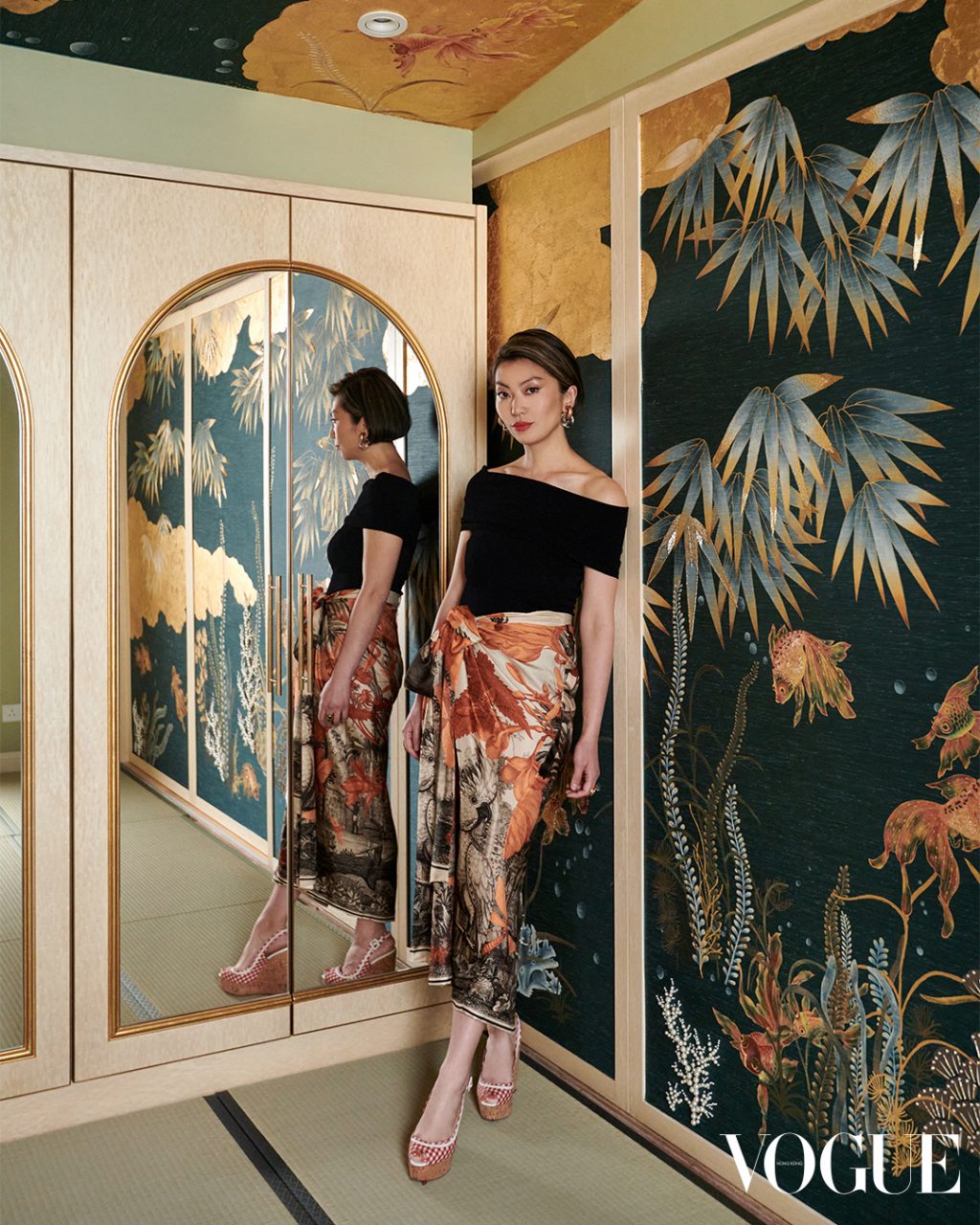One of the most prominent art collectors in Hong Kong, Evan Chow is also the managing partner of MCL Financial Group and a descendent of the Lee family, who founded the Bank of East Asia. As a member of the board of trustees of the New Museum of Contemporary Art, a member of the Cercle International of the Pompidou and founding patron of M+ Museum, his influence in the art world is undisputed. Chow started his career as an art collector in 2013, and has collected over two hundred works to date.
The living room of Evan Chow's home in Pak Sha Wan.
Photo: Natalie Dunn
Ten years ago, he bought his house in Pak Sha Wan, Sai Kung for a weekend home where he could host gatherings with family and friends and display his art collection. Sai Kung’s lush natural landscape and proximity to the sea makes it the perfect tranquil escape.”When I look for a home, I look for somewhere that is close to the sea. Comfort is also a key consideration. In terms of space, my ideal home has to accommodate my growing contemporary art collection, because art is the protagonist of the house.”
In Chow’s words, his weekend home is “warm, comfortable, modern, elegant, slightly playful, and designed for intimate gatherings.” He hired a local architect, who also lives in Sai Kung, to helm the interior design of his home. “He has a wealth of experience when it comes to housing projects. We worked closely for a year to execute this current design. Inspired by Pak Sha Wan’s dreamy sea view, we decided to create a riviera-style beach house with a modern interior. Two years ago, a small-scale renovation was carried out to accommodate the latest additions to my art collection — the selection changes every year.”

Chow integrates a collection of glass dishes and silverware from his grandmother into his Christmas table set up, making the layout extra meaningful.
Photo: Natalie Dunn
Chow’s love for collecting art stems from his grandparents’ love of collecting traditional Chinese ink paintings and ceramics. “But I was determined to collect contemporary art as I like to support young emerging artists.” The influence of Chow’s grandparents on the art collector is evident from the antique furniture in his Sai Kung home. “The green glass dishes and silverware on the dining table are from my grandmother. In the 1960s, she won the best table setting award for this series of Beijing glass dishes.” While Chow’s home is adorned by a myriad of contemporary works, pieces he inherited from his family can also be spotted in different corners of the room.
The way Chow showcases his art collection in his home reflects his dedication to the craft. In addition to assigning a different theme to each floor, he also switches up the colours of his walls every two years when he changes his art display. “Each floor in this four-story building interweaves different themes together to create interesting dialogues between some of the most laudable and exciting emerging artists of our era.” Upon entering the Chow’s villa, one will be met by a series of abstract works, and the journey through his home ends with figurative art on the top floor. The kaleidoscope of colours in the space makes it full of surprises.

Dialogue between pioneer of minimalist art Donald Judd’s "Everyday activity #12" (1991) and Chinese artist Huang Rui's work "Space Structure 84-15" (1984).
Photo: Natalie Dunn
The living room has a high-rise ceiling and is decorated with works by emerging multimedia artists, hung on walls painted in a mesmerising indigo blue. The dining room on the first floor houses abstract, geometric art by masters of minimalism Donald Judd and Kusama Yayoi, whose works are displayed diagonally across each other — for a special reason. Donald Judd was one of the first critics to appreciate Yayoi Kusama’s paintings. The two artists became roommates, and in placing their works across each other, Chow re-creates a narrative of the past. “I especially like this space on the first floor. You can walk several steps from the dining room and you’ll be able to overlook the living room.” The abstract art displays on the second floor slowly transition into figurative pieces as we reach the top floor. “On the second floor, you can see artists pushing the boundaries between abstract and figurative art — this divide between the two movements is sacred to older artists, but young emerging talents of our generation are questioning and crossing these lines with confidence through creating subversive art.”

Hong Kong artist Chris Huen’s "Juan" (2019) contrasts with the magnificent natural scenery outside the window.
Photo: Natalie Dunn
Chow’s favourite lounge lies past his bedroom at the end of the corridor on the top floor. “I placed Hong Kong painter Chris Huen’s 2019 work “Juan” in this room. The way he portrays the chaos of daily life provides an interesting contrast to the serene natural landscape outside the window. I spend a lot of time reading here and this is where I host intimate gatherings with my family and friends.” Whenever he comes to his weekend home, Chow spends half his time in the garden by the pool. “For furniture, one of my favourite pieces has to be Milo Baughman’s sofa, I really enjoy looking out at the garden and Pak Sha Wan from here.”

"Birds and Melons" (2018) by Katherine Bernhardt, an American artist who has been very active in recent years.
Photo: Natalie Dunn
Chow specifically mentioned three pieces of art in his house: “’FS Interval II’ created in 2014 by American artist Nick Mauss comprises three-sided inverted painted glass mirrors, which have been processed to look vintage. It was displayed at the Walker Art Center in the United States. I am a loyal Mauss fan as his work recalls stylistic elements from 19th century European decor and Parisian salons. He creates movement and rhythm through the mirror’s reflections, and incorporates expressive imagery and calligraphy on the back of the mirror. The silhouette of a naked woman’s back can be seen in this particular work, recalling the sensual female figure in “The Death of Sardanapalus” by French romantic painter Eugene Delacroix. Mauss’ pieces also take cues from modern ballet, which I find really intriguing. On a memorable trip to Beijing many years ago, I visited the studio of Chinese artist Huang Rui, who has become one of the most influential artists of his era. His “Space Structure” series is displayed next to Donald Judd’s Menziken box. These are the recent highlights of my art collection.”
Aside from his spectacular art collection, a multitude of Berluti furniture pieces can also be seen in his Sai Kung villa. “Berluti’s furniture first caught my attention because of the brand’s previous collector series, which included pieces by famous Swiss architect and designer Pierre Jeanneret, refurbished using bronze coloured leather. Also, Berluti’s antique Venezia leather comes in stunning hues! Their club chairs were originally designed for their shoe store to enhance customer experience — the history and craftsmanship that come with their furniture is what I appreciate most. Berluti’s marriage of modernism and legacy is of particular interest to me, especially in the Le Corbusier Chandigarh city project and Radiant City project.” Recently, Chow has also curated a selection of pieces by artists such as Tomma Abts and Donald Judd from his personal art collection for Berluti’s new home collection pop-up in Hong Kong, taking the relationship between art and furniture onto the next level.
Editor
Karma CheungCredit
Photography: Natalie Dunn; Translation: Kaitlyn Lai













